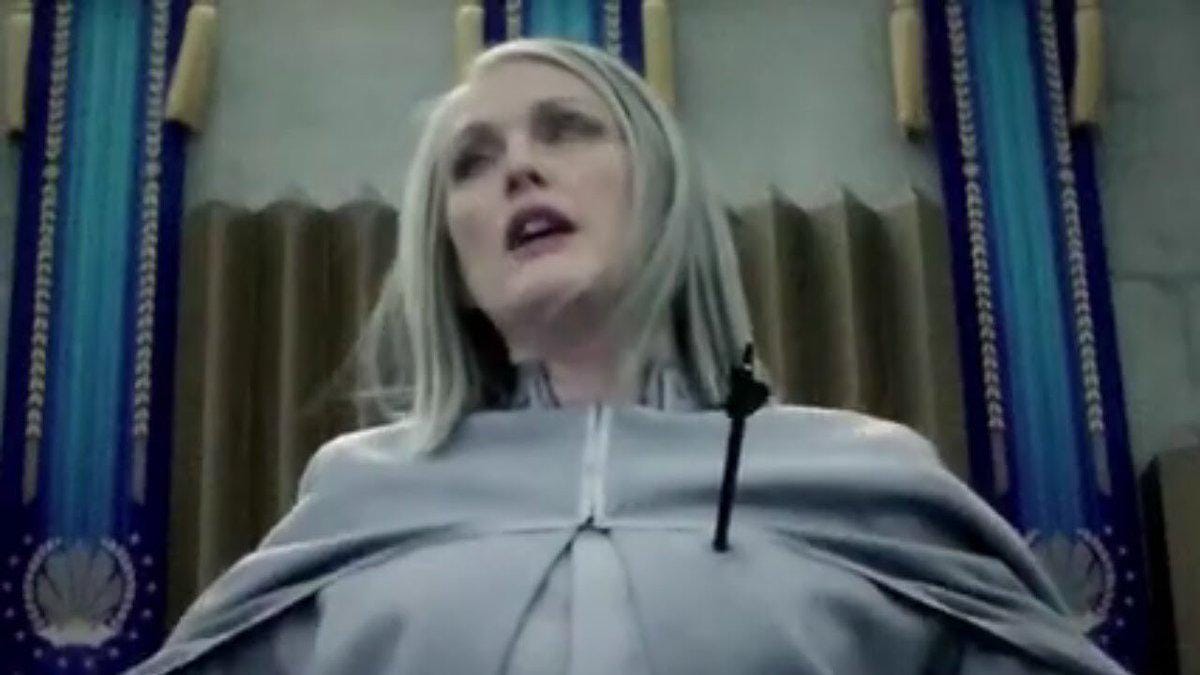The Most Important Narrative Tool No One Told You About
Narrative Distance, and Saying "No" to the RPG Video Game Camera
There’s one important part of narrative that is almost completely overlooked, a tool for crafting a story that seemingly no one has heard about.
I’ve even seen podcasts & panels where very established fantasy authors twist themselves into mental knots trying to articulate tradeoffs between narrative styles, but fail to do so because they’re missing this one single term from their critical vocabulary.
The missing term? Narrative Distance.
(No, not “narrative voice”. Narrative distance.)
I myself was a longtime student of narrative and writing—as well as a student of history where unpacking points of view and biases is half the craft—before I ever even heard about “narrative distance.”
But once it was explained to me, it slowly transformed the ways I see stories on-page, on-screen, and within my own writing. (As a result, I am eternally grateful to
for being the one to teach me the term; he has his own piece on this topic that I’ll link below.)Analyzing narrative distance gave me the terminology to express why I disliked certain popular series (namely The Hunger Games), why I sometimes tire of even very good series (like the works of Robert Jordan & Brandon Sanderson), and why my favorite epic fantasy authors have become my favorites (authors like J.R.R. Tolkien, Tad Williams, and Terry Pratchett).
Yet “narrative distance” seems to be something no one talks about.
So let’s talk about it.
What Is Narrative Distance?
Narrative distance is the perceived separation (you know, the distance) between the reader and the story unfolding (the, uh, narrative). Crucially, that distance is controlled by the narrator, whomever/whatever they are.
That distance between reader and events can oscillate over the course of any story—indeed, the vast majority of stories will change the narrative distance throughout, even when bound within a small range. You’re probably doing it yourself in your writing, even if you’ve never heard of this.
But what does this actually look like? Visual language can help here.
Some stories are very “zoomed in.” We see what the characters see, perhaps even reading their thoughts. The narrator (who may be a character within the story) may describe every tiny detail of a scene or a person. We get characters’ emotions very clearly, plus reactions to every event, and the blow-by-blow of every scene. Every scene has a clear sense of place and timing.
Other stories are very “zoomed out.” The narrator is detached from the story. The reader sees things from a bird’s eye view, often becoming aware of things the characters themselves don’t know. A “far” distance will include more summary, and might just “tell” the reader things instead of “showing.”
Some examples: action scenes tend to be very “close,” because we’re getting details about tiny actions that characters take; to get our adrenaline pumping, we need to feel the excitement or fear of the characters, and that goal lends itself to a close distance. But every story will have its moments of summary (“The next few weeks were a hard time for Johnny…”), simply because the time passing in-universe is different than the pacing required of the story.
On the extremes?
The closest possible narrative distance are those spots in a story where we hear everything a character does, read their thoughts, know their inmost emotions, and we get every beat told in vivid detail. The furthest possible narrative distance would be an objective recounting of events without emotion or detail, much like an encyclopedia entry.
Wait, This Is Just Narrative Voice!
Not exactly. But the two are absolutely related!
Narrative voice = the personhood of the narrator + the verb tense. (I know, I know, grammar. Ick. Bear with me).
Every story is told from some perspective, grammatically labeled as first, second, or third person. There’s all kinds of reasons to choose one of these over the others, depending on the type of story you want to write.
You might tell a story in first person (I slew the dragon) if the narrator is or was a character in the story and is recounting it to the audience, or to a surrogate audience through a frame story.
You might tell a story in third person (he slew the dragon) if you want to be able to jump around from place to place and person to person, and you don’t want to be limited to one character’s perspective and bias.
You might tell a story in second person (you slew the dragon) if you’re a sadistic try-hard who revels in committing unspeakable crimes against the English language and you want to write a book that will alienate your audience whenever they try to read it.
The other half of narrative voice is verb tense, namely past or present. (Future-tense also exists, but that’s another one for the deviants and evil-doers. If you make a story in second-person future tense I will call the police. If you want to actually be avant garde then write a novel in fourth-person present-perfect-simple tense. Then I’d be impressed. Still wouldn’t read it, but I’d be impressed.)
How an author chooses between these two categories—person and tense—dictates the narrative voice. And the chosen narrative voice greatly dictates the options available to them for narrative distance.

How Voice Dictates Distance
First Person is going to give a very close narrative distance for the whole story. We’re locked into one person’s perspective the entire time; this can get even closer if the narrator is also the protagonist (Katniss in The Hunger Games or Uhtred in The Saxon Tales); but even if the narrator is an observer to the story (like Watson to Sherlock Holmes or Nick Carraway to Gatsby), the narrative distance is still locked in pretty close.
Third Person gives the option to be close or more distant: limited or omniscient (or anything in between).
Many pieces of fiction are third person but still adopt a clear “Point-of-View Character,” whose mind functions as the surrogate “camera” for the reader’s imagination. This sort of limited third person POV still generates a close distance overall.
This is a very good thing! A close narrative distance makes it easy for the readers to understand and empathize with the POV character. This can be a powerful tool to invest readers into the story!
Meanwhile, an omniscient, “tell the reader everything” narrator is naturally going to make the reader feel more distant from the characters, since they can view the story separately from the way the characters do.
This is also a very good thing! Dramatic irony is only possible when the reader knows things the character doesn’t.
Either way, you have certain options and limitations.
Meanwhile, choice of verb tense further restricts that narrative distance. Present tense is far closer than past, compounding the “empathize/sympathize/understand” factor of the narrator, but reducing the storytelling options available to the author.
This is why authors need to be aware of the choices they make and know their own reasoning. Otherwise, they’ll write themselves into trouble.
How Close is Too Close?
There are places where a chosen narrative voice can significantly harm a story—not because it’s a “bad voice,” but because it restricts the narrative distance in a way that does not best serve the story.
One glaring example is actually the first time I noticed it—even before I knew the term “narrative distance”—The Hunger Games trilogy. (spoilers ahead)
The story is told exclusively in first person present, the voice with the closest distance. This means that Katniss, the narrator, is much more likely to resonate with the audience (especially among a certain subset of pre-teen girls).
But this is an incredibly restrictive distance, especially for a story that becomes a sprawling epic, with far-reaching events. Suzanne Collins wants to explore deep themes of autocracy and power, propaganda and decadence… but we’re eternally trapped in the momentary perceptions of a single teenage girl.
… and if you don’t like that girl, then boy oh boy you will not like these books.
We only know what Katniss knows and can only understand any other character insofar as Katniss understands that character. You cannot tell the audience anything without telling the narrator (Katniss) that something. And because it’s present tense, recollection becomes nearly impossible. We readers can only process past events if Katniss stops whatever she’s doing and does some processing in the “present”. Every emotion, every psychological development has to be tied to a specific moment, that moment being “right now.”
This leads to many sequences where Collins has to describe Katniss wandering around generally feeling sad, going over past events in her mind to decide how she feels and to remind us that they did happen.
Likewise with big decisions and events: when Katniss decides at the end of book three to shoot President Coin instead of President Snow, it’s meant to be a triumphant rejection of the new status quo, a potent message about the dangers of regime change and the potential for evil among every political movement.
Nonetheless, this decision has to be made in the present, as a sudden and momentary decision, otherwise there will be no reveal, no plot twist, no surprise.
Collins robbed herself of having Katniss be able to weigh these sorts of decisions ahead of time, because we’re always in Katniss’s head, always in the right-now.
The result? A teenage protagonist who makes huge, earth-shattering decisions based on impulse and whim. That’s not at all what Collins meant to do, but it’s why myself and a lot of other people never really liked Katniss.

First person isn't bad, and present tense isn’t bad, and putting them together is also not bad. But do they serve the story best? In this case, absolutely not.1
And that brings me to a particular pet peeve of mine, and really the whole reason I’m writing this…
The RPG Video Game Camera
This “restriction” problem bleeds into my forte of epic fantasy in one particular way: over-reliance on third-person limited POV, or what I call the RPG Video Game Camera.
With the RPG Video Game Camera, the reader is always glued to one character at a time, and we’re “over their shoulder,” seeing what they do, hearing what they hear, going where they go.
Like playing an RPG video game.
It’s a very popular narrative voice. Jordan’s The Wheel of Time, Sanderson’s Stormlight Archives, and Martin’s A Song of Ice and Fire, all follow the same format: each chapter is limited to a single “point of view (POV) character,” who is the primary surrogate for the audience.
And it’s popular for good reason! It has its obvious advantages.
This is like first-person in that it’s a relatively close narrative distance.
We really get to know a few important characters and hopefully learn to love them
We get multiple points of view over a book or series which can be used for dramatic irony, getting around some “first-person-only” narrator problems.
The author can jump around far-flung locations (by jumping between POV characters) and follow threads that may only connect in the final acts of the book.
We get to feel very immersed in the world, because we’re experiencing it through someone who is a part of it.
But there’s also some pretty big problems, and I argue they negatively impact every one of the three series above.
If the audience finds one of the POV characters unenjoyable, they simply won’t enjoy the chapters that go through their eyes. An annoying POV character can bounce a reader out of a book.
As with first-person narrators, any reveal or new piece of information has to be revealed to the audience through a point of view character learning that information, or something similar. If someone is doing something secret, you can only tell the audience by first going into the secret-keeper’s head, or waiting for an established POV character to learn the secret.
This also can lead to some clunky scenes where the author has to contrive reasons for characters to be together, so that the reader can learn or witness things through an established POV.
Because every POV shift requires a slight tonal change in the voice of the narrator, it’s necessary to do some re-expositing2 every time the POV shifts. Before the events of the chapter, there’s usually a re-acclimation period.
This distance also often relies on flashbacks in order to reveal things about a character. Now this can be extremely powerful (see The Way of Kings), but it’s worth seeing how an RPG Video Game Camera forces you into a total re-telling of a flashback, much like an RPG cutscene. It can’t happen quickly; it can’t be retold to another character. It has to be lived, through the eyes of the POV character. Hence: flashbacks and more flashbacks!
Readers of the Wheel of Time know what I’m talking about: a lot of Wheel of Time chapters follow this exact formula: Re-introduce POV Character A, explaining where they are, what they’re doing, why they’re doing it, what their problems are, then the entire plot of the chapter is them learning a single piece of information about someone or something. Then, the next chapter will be the POV of Character B—reestablishing their own problems and motivations—re-hashing the same events we just saw, but retrospectively and now in a new character’s head. This adds lots of depth to events, but my WORD, a lot of ink is shed for very little plot.
Even when things aren’t that slow, big world-building reveals have to be done with the RPG Video Game Camera. When (mild spoiler) the Rand Band all learn about the origins of the Aiel, it has to be done through visions, where the POV characters experience ancient events through their own POV characters. Jordan can’t just explain it. His chosen distance requires several layers of vicarious observation.
There’s a reason Wheel of Time is a whopping fourteen books…
…for events that span three years!
I can think of plenty of times where Sanderson’s characters in Stormlight get contrived into certain situations where they all end up witnessing important events together. You always know when big things are gonna happen because everyone’s there. But because the POV can only change between chapters, and a full story requires depth from multiple points of view, usually only one or two things can really happen in each chapter (of 5,-6,000 words a piece).
That’s one reason why the Stormlight books are all nearly 400,000 words long.3
And George R.R. Martin has expressed the challenge of being locked into certain POVs as one of the reasons he still can’t finish his series.4
I love Wheel of Time and Stormlight Archives both. They are excellent stories and worth a reader’s time, I’d say. Jordan and Sanderson chose this as the narrative distance and the vast majority of the time they use that distance extremely well. But there are limits.
I think a lot of us writers take the RPG Video Game Camera as the default for any piece of fiction. We shouldn’t.
Although it’s a strong voice, we should recognize the limits.
And you, dear reader, shouldn’t use the RPG Video Game Camera unless you think it will best serve your story. Maybe it will!
But also maybe it won’t.
Tolkien as a Counter-Example
I’ve told you about the value of a close distance and many of the overlooked problems.
I want to finish with one counter-example from The Return of the King which demonstrates the power of a farther-out narrative distance.
It comes in Chapter 10, “The Black Gate Opens,” as Aragorn and his army are marching to Mordor to lure Sauron’s army out, and thus give Frodo a chance to destroy the One Ring.
Tolkien writes:
So desolate were those places [the outskirts of Mordor] and so deep the horror that lay on them that some of the host were unmanned, and they could neither walk nor ride further north.
Aragorn looked at them, and there was pity in his eyes rather than wrath; for these were young men from Rohan, from Westfold far away, or husbandmen from Lossarnach, and to them Mordor had been from childhood a name of evil, and yet unreal, a legend that had no part in their simple life; and now they walked like men in a hideous dream made true, and they understood not this war nor why fate should lead them to such a pass.
‘Go!’ said Aragorn. ‘But keep what honour you may, and do not run! And there is a task which you may attempt and so be not wholly shamed. Take your way south-west till you come to Cair Andros, and if that is still held by enemies, as I think, then re-take it, if you can; and hold it to the last in defence of Gondor and Rohan!’
Then some being shamed by his mercy overcame their fear and went on, and the others took new hope, hearing of a manful deed within their measure they they could turn to, and they departed.
It’s not a particularly long passage nor is it vital to the story. It’s mostly to show how terrible the land of Mordor is, and how adept and compassionate a leader Aragorn is.
And it’s only about 200 words!
Consider what we don’t have: There’s no single POV character, just a detached narrator. We don’t have any physical descriptions. We don’t know in what precise manner Aragorn addressed these men, or what time of day, or how long this “unmanning” took. There’s nothing by way of setting, really. Our imagination must fill in all the gaps.
Nonetheless: this constitutes a complete episode. And because Tolkien is employing a far-viewing narrative distance, we can move from Minas Tirith to the Black Gate in only a few pages.
Consider what would have happened if this were Wheel of Time or Games of Thrones, and we were locked into the RPG Video Game Camera.
It would take a full chapter to do all the following:
establish the POV character, probably Aragorn
he learns of the men’s wavering courage (as does the reader)
he formulates a plan, probably by speaking with other characters because it would be boring otherwise
then he marches out into the camp (much sensory description required)
where he gives a roaring speech
then we see the reaction of the men, and someone will have to explain (probably in dialogue, or a big huzzah, then and there) that the speech has worked.
It’s 5,000 words, at least!
With Tolkien? 200 words. Done and dusted. And it’s no less evocative for that!
That’s the power of narrative distance.
✹ ✹ ✹
I owe a huge shout-out and round of thanks to my friend
who first introduced me to the concept of narrative distance. Since the initial publication of this article, Ian has gone and written his own about the value of “Variable Zoom,” which is the device of sliding or jumping between different narrative distances within a single narrative. If I’ve managed to convince you that choosing the right narrative distance is vital for your story’s success, let Ian convince you that you don’t even need to choose just one distance.✹ ✹ ✹
If you like what you’ve read here and want me to keep making stuff like this, you can help me do that by liking, commenting, or sharing this piece.
Want more? Check out the piece below. Or you can see all my writing by visiting this page.
✹ ✹ ✹
✹ ✹ ✹
I should at least note that the close narrative distance serves the first book very well, in that Book 1 is about intense, brutal action in the Games. The tribune-children are meant to be like hunted prey animals, and the never-ending present-moment helps imbue the writing with the sort of panicked urgency that a deer might feel when the wolves are closing in.
re-exposit: from the base to exposit (verb): the act of giving the reader exposition. Etymology: me. Right now.
Or as Mary Robinette Kowal affectionately calls Brandon’s Stormlight books, “chihuahua killers.”
That, and Martin clearly didn’t plan ahead on a lot of stuff.







Great article! I’ve also never heard of narrative distance before, but you’re right that it’s such a helpful way to think about things. I had to stop reading for a couple moments though to laugh at your description of the second person 😂 I don’t disagree at all, but I’ll admit I am one of those sadistic folks who kind of loves it. I don’t really use it at all, but I will give anything a shot if it uses the second person. I wrote a short story in 2nd many years ago that forever endeared me to it. Did I only do that because my middle school English teacher told me not to? Yes. Yes, I did.
I think a lot of authors write with video games/movies in mind. So what ends up happening is basically games/movies being transcribed into a book. And I'm not saying this to pick on others, I find myself falling into this trap myself too.
But once you write books as books, then you'll have a lot more options. You want to explore a character's state of mind? You're no longer limited to just dialogues and expressions. Exposition? You don't have to be limited to characters giving each other history lessons or their backstory.
This is what I'm trying to do with my recent stories like 'The Santara Commentaries' or 'Love Your Enemy' where I just tell (*gasp*) the world's lore or the character's backstory. I'll let the readers decide how good my openings are. But I like that I was able to accomplish in just 100-200 words what most authors would take at least an entire chapter.